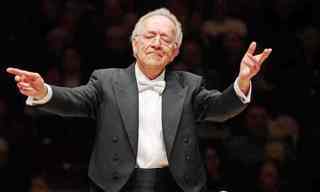|
Back
A Singular Richness New York
Issac Stern Auditorium, Carnegie Hall
03/04/2017 -
Johannes Brahms: Piano Concerto No. 1 in D Minor, Opus 15
Dmitri Shostakovich: Symphony No. 5 in D Minor, Opus 47
Nikolai Lugansky (Pianist)
St. Petersburg Philharmonic Orchestra, Yuri Temirkanov (Conductor)

Y. Temirkanov (© Hiroyuki Oki/GettyImages)
“A desperate hash of bits and scraps, with thickening in the piano part.”
George Bernard Shaw on Brahms’ First Piano Concerto
Russia was screaming not only politically across the news broadcasts yesterday. On 57th Street, Russia was in the air. Literally! The frosty bracing St. Petersburg air on this March evening, plus the usual coterie of anti-Putin protestors forcing pamphlets and screeds on unaware passersby. And of course the St. Petersburg Orchestra inside Carnegie Hall, produced by a new (to me) mainly Russian arts group called appropriately enough, “Cherry Orchard Festival.”
Yet after the concert, waiting hopelessly for a troika to carry me home (and finally settling on a subway), it was the sound and singular performances of this 140-year-old orchestra.
These days, when one thinks of Russian concerto performances, the first names coming to mind are Valery Gergiev and Daniil Trifonov, and for good reason. Their performances are hair-raising, electrifying. Not a second goes by without the feeling that, should the mind wander off, one will miss more exhilaration. Great stuff.
Conductor Yuri Temirkanov is made of different material. Not that his conducting was anything but exciting. Yet that excitement was less arrow-sharp, it had more breadth, more room to breathe. The Shostakovich Fifth, as always, finished with brassy explosions, but before that, Mr. Temirkanov led his orchestra (most decidedly “his”, having been conductor and Musical Director for about three decades) with a style where clarity and musical logic were more essential than kinetic energy.
For the Brahms, the Maestro wasn’t idiosyncratic with pacing, moving all three movements along. Yet one didn’t feel the fire of the relatively young Brahms. One felt a comfort, as though the elegant lines–hardly Shaw’s “bits and pieces”–had a place for themselves.
In both works, the St. Petersburg Philharmonic Orchestra offered sounds far different from our American orchestras. Four nights ago, the Boston Symphony Orchestra gave us another Shostakovich symphony (the Seventh), where each instrument gave their all with alacrity, pinpoint accuracy. Not quite a machine, but with an almost disconcerting perfection.
The St. Petersburg Orchestra was another kettle of sturgeon. The brass were louder, the timpani more booming (appropriate in the Shostakovich, not so much in the first movement of the Brahms), and the violins played their bows hard on the strings. If notes didn’t come to an end always sharply, that infinitesimal holdover was like a light resonance, not the least bit displeasing.
(Incidentally, Mr. Temirkanov’s well-known musical misogyny was apparent, with all the women fiddlers placed firmly in the back of the ensemble.)

N. Lugansky (© Beckmesser.com)
In the Concerto, the young and brilliant Mr. Lugansky was the anti-Trifonov. This was not an ecstatic Brahms, it was an endearing, subtle Brahms. The pianist is so confident in his wonderful playing that he was never averse to sharing the honors with the orchestra itself.
That first entrance didn’t come to introduce a new melody, but to wander over the keys, as if to make us feel comfort in the music. As the movement progressed, it took a conscious effort to note how wondrous were Mr. Lugansky’s hands. So much was he partnered with the orchestra that the music sounded at times more dense than necessary. But one felt that Brahms, not Lugansky, was the winner.
The second movement was for the pianist alone. The Adagio could have been tears for the death of Schumann or joy with the love of his wife. But the latter seemed to be Platonic here. The rapture was that of a starlit night, not a candlelit boudoir. And for the finale–a movement often tossed off as if Brahms simply wanted to show his the artist’s skills–Mr. Lugansky again was relatively conservative. A great pianist simply pushed the prodigious difficulties into tools, and produced a work of natural beauty.
And retaining this so admirable reticence, his encore was not (what I would have expected) Rachmaninoff or Scriabin, but a simple Mendelssohn Song Without Words, elegant and on the cusp of luscious.
The second D Minor work on the program, Shostakovich’s Fifth Symphony, has a special place in the St. Petersburg Orchestra. This was the composer’s only real home, and under its nom de politique, Leningrad Philharmonic, the orchestra premiered the work in 1938. If that gave them authority, Mr. Temirkanov never had to replicate the original. In fact, while those first measures were taken boldly enough, the first movement was not actually electrifying. The conductor took it at a deliberate pace, as if telling us a story, so we felt we had to listen to each note.
The scherzo was one of those goofy circus tunes, bursting out with some terrific solos by the first chair players. The conductor began the finale with the third-movement Adagio. That is, once he raised the baton on those solemn deep themes, it was impossible not to be mesmerized. Not lulled, mind you, but spellbound enough that the first notes of the Finale became an inevitable victory over pathos.
One is tired of reading about the “real” meaning of this finale. When a conductor like Yuri Temirkanov brings those brassy brass and the reverberating cymbals to the fore, the entire Fifth Symphony produces not sound and fury, but an infinite and endearing richness.
Harry Rolnick
|